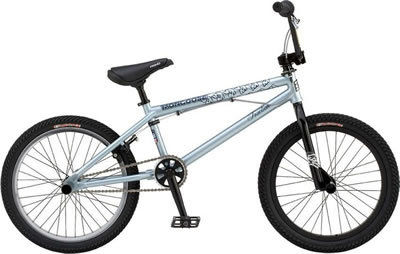BMX Bikes

General Description...
BMX originates back in the late 70's but peaked in popularity in the early eighties. Originally the human powered form of Moto-Cross where instead of a motorbike, riders would tear round a circuit of bumps and jumps on a small wheeled bike with a single gear. BMX (Bicycle Moto Cross) gradually developed and manufacturers began to make bikes which suited the circuits. They were fitted with 20" wheels, had a relatively small frame and high bars. Some of the professional bikes would run on 20"x1 3/8" wheels whereas the majority of bikes were fitted with 20" x 1.75 or 2.125 wheels. They have a fixed frame size, with no frame sizing options being available for a given wheel size.
The style of bike became very popular with the younger rider, particularly teenagers who adopted this new "style" of bike as their own. As with many types of bikes, the BMX evolved into more than just a race circuit bike.
BMX bikes tend to be stronger, due largely to their small frames, and because they have only a single gear, they tend to need less maintenance.
Although BMX faded away in popularity when Mountain Bikes really began to catch on, a core of riders and enthusiasts has kept the "style" alive. More recently BMX has seen a resurgence in popularity.
BMX bikes are available with other wheel sizes, although these smaller wheeled (12", 14" 16" and 18") bikes are purely childrens' bikes.
The style of bike became very popular with the younger rider, particularly teenagers who adopted this new "style" of bike as their own. As with many types of bikes, the BMX evolved into more than just a race circuit bike.
BMX bikes tend to be stronger, due largely to their small frames, and because they have only a single gear, they tend to need less maintenance.
Although BMX faded away in popularity when Mountain Bikes really began to catch on, a core of riders and enthusiasts has kept the "style" alive. More recently BMX has seen a resurgence in popularity.
BMX bikes are available with other wheel sizes, although these smaller wheeled (12", 14" 16" and 18") bikes are purely childrens' bikes.
Types of BMX:
Race;
The original. No Frills, just a machine built for speed around a dirt covered track with humps. Typically fitted with frame pads to protect the rider.
Freestyle;
The first evolution of BMX. Designed to be ridden purely to perform tricks and stunts. Smooth tyres instead of knobbly ones are fitted, and they usually have some form of mechanism to allow the steering to be rotated fully through 360º without entangling the brake cables.
Freestyle is generally split into 2 main types; Ramps and Street (Flatland). Freestyle bikes for ramps tend to be slightly longer in the frame than Flatland bikes. Ramps are built in the form of an elongated semi-circle where the rider goes back and forth between the 2 ramps performing aerial tricks after leaving the ramp at the top (Half Pipe) or a single ramp where there is just a long run up (Quarter Pipe). Flatland bikes are shorter, and riders perform a series of tricks, moving the bike around on one wheel and many others without allowing their feet to touch the ground.
Freestyle is generally split into 2 main types; Ramps and Street (Flatland). Freestyle bikes for ramps tend to be slightly longer in the frame than Flatland bikes. Ramps are built in the form of an elongated semi-circle where the rider goes back and forth between the 2 ramps performing aerial tricks after leaving the ramp at the top (Half Pipe) or a single ramp where there is just a long run up (Quarter Pipe). Flatland bikes are shorter, and riders perform a series of tricks, moving the bike around on one wheel and many others without allowing their feet to touch the ground.
Dirt Jump;
The latest evolution. In many cases this is freestyle taken onto the dirt. Riders build ramps from piles of earth and then jump over the ramps, performing aerial tricks whilst off the ground.
Pros...
Most BMX bikes are very solid and robust. They tend to be more durable than other equivalently priced bikes. Less maintenance due to less individual components.
Cons...
Not suitable for riding any long distances, due to lack of gears and small frame/wheel size. Not as indestructible as they appear. One key factor to remember with a BMX is that it can only be as capable as the rider. As with any style of bike, there are "imitations" ie bikes which look like a BMX but which are not suited to any form of extreme riding.
Tricks should not be undertaken without an awareness of the risks involved.
Expect to Pay...
BMX "Style" Bikes start from around £60, but realistically, the starting price for a real BMX or Freestyler is around £180.
Image Copyrights
Images depict bikes manufactured by Mongoose.BMX bikes are available from a number of other manufacturers and use of Mongoose bicycle images is in no way an endorsement of their product for this purpose.
Permission for use of the images has been sought from Mongoose UK (Hotwheels) and copyright over these images remains with the respective supplier.
